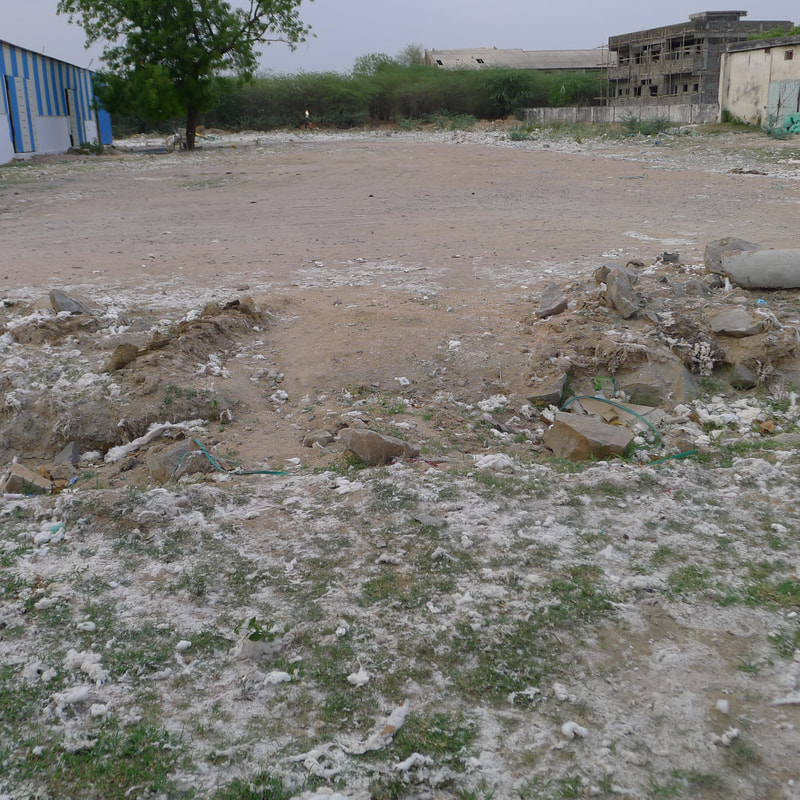
We learned a lot during this short trip—and not all of it was directly related to YESS (for more on YESS, you will have to wait until my next newsletter to read about our YESS research, which is still ongoing). I would like to focus on one thing I learned that has stuck with me: In our visits to farms, gins and spinners, I saw real potential to improve productivity and efficiencies, and to preserve the quality of cotton lint in the farm and ginner portions of the supply chain.
Last year, India produced more raw cotton than any other country. This is quite a feat when you consider that India grows cotton under the least efficient conditions—by individual farmers on small plots of land, many without irrigation, and, presumably, with sub-optimal production practices.
The operations at the gin did not appear to be optimized either. We saw firsthand the amount of cotton that was lost to the environment during the ginning process (see photo below). In addition, heavy equipment is often running over lint that is spread across floors, and no personal protective equipment is used to prevent hair from contaminating the cotton lint. Hair is one of the two most common and detrimental contaminants—plastic is the other—when lint is spun into yarn and dyed.
The conditions at the gin are a real contrast to the spinners we visited, who are very good at preserving cotton quality, capturing all cotton, and reselling what doesn’t qualify for use in first-quality yarn to furniture manufacturers or open-end spinners who produce lower quality yarn, for example. Workers at the spinning mills we visited wore hair caps to prevent hair from contaminating the yarn and had vacuum systems to remove shorter length (or otherwise inferior) cotton from the final yarn.
The spinners’ ability and desire to optimize their methods to preserve the quality of cotton lint and capture all byproducts throughout their processes may be in part due to their higher value part of the chain (and higher value material and byproducts). In India, the spinners also benefit from recent investments by the Indian government, through its Technology Mission on Cotton, to upgrade spinning facilities. Similar investments and advancements at gins have been slower.
Increases in productivity and lint quality at the gin appear to be low hanging fruit, based on my limited observations. I saw several areas where ginners could protect the lint from damage, contamination, and exposure to dirt and moisture, which harms the fiber. Easily implemented changes include simple facility enhancements, such as more protective enclosures / semi-enclosures to lessen damage due to heavy equipment, and operational improvements, including requiring protective gear for workers to help prevent contamination by hair and plastic. These changes could also lessen loss of fibers to the environment, thus increasing process yields.
Making improvements at the farm will be more difficult, but they will yield important benefits to individuals, communities and the entire apparel supply chain. Agriculture plays an important role in providing income for small-scale farmers and alleviates extreme poverty in rural areas of developing countries. Approximately 75 percent of the world’s poorest people live in rural communities, many of whom depend on agriculture for their livelihoods[1]. Cotton is grown in more than 100 countries, 50 of which depend on cotton for a significant portion of their export earnings[2]. In fact, more than 100 million family units are engaged directly in cotton production, and ancillary involvement is estimated to reach one billion people worldwide.[3]
Fortunately, the Better Cotton Initiative (BCI) is succeeding in their efforts to help farmers adopt better production practices, and the BCI is gaining support among the apparel industry.
Another way to help cotton farmers to improve the efficiency of agricultural land and increase their income is to provide efficient irrigation. On average, irrigated crops produce two to three times more than those raised in rain fed areas. Irrigation improves the efficiency of productive land and provides farmers with greater yields. Additionally, family income can increase by as much as 44 percent when farmers add irrigation (compared to crops that only receive rainwater), and by up to 66 percent when farmers also use higher quality seeds.
The benefits of providing efficient irrigation across all crops can be significant. For example, the International Water Management Institute estimates that 75 percent of the additional food that will be needed in the future can be supplied by improving water productivity on existing irrigated land. This jump in yield would prevent the need to convert natural ecosystems for agriculture production.
Consider the environmental impacts from the material loss at the gin and on the farm, and changes in land use (including conversion of natural ecosystems to agriculture). When we account for those impacts, I believe that apparel brands could reduce their supply chains’ overall footprint and improve their final products by helping the cotton industry reduce production losses during the ginning process. They could further reduce their footprints by supporting farmers’ efforts to adopt better production practices and increase yields, including the use of efficient irrigation. Apparel makers can also help alleviate poverty in farming communities by promoting improved yields and quality preservation. I know it is a lot to ask that brands in particular, and the cotton industry as a whole, address opportunities at gins and the need for irrigation on a large scale. But I hope these issues get the attention they deserve in the not-so-distant future. If the industry gets behind these improvements, they will help many people who are the most in need.
[1] Ayres W., McCalla, A., No date. Rural Development, Agriculture, and Food Security.
[2] International Cotton Advisory Committee. June 2008. Commodity Profile: Cotton.
[3] ibid

 RSS Feed
RSS Feed